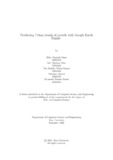Predicting Urban trends of growth with Google Earth Engine
Date
2022-09Publisher
Brac UniversityAuthor
Islam, Rifah TasmiahMim, Md. Shahriar
Tahiat Seeum, Nur Fathiha
Ahmed, Tahmina
Nawar, Tabassum Tanzim
Metadata
Show full item recordAbstract
Land Usage is one of the most pressing concerns confronting the landscape of
Bangladesh due its heavily dense population and limited area. Rapid urbanization
has been seen in different parts of Bangladesh, so factors like change in infrastructure, decrease in agricultural land, decrease in greens and water body, as well as
a steep increase in built ups are being observed all over the country. Hence, it is
critical to have an overall concept of the urbanization trends in order to plan infras tructures, make policies and to conduct large-scale comparison studies. This paper
presents a general framework to detect urbanization patterns and transformation
of forested areas to residential or commercial developments, specifically in Dhaka
division of Bangladesh using Machine Learning Algorithms (MLA). Moreover, for
monitoring land coverage change we will be using Google Earth Engine (GEE) data
which has a high accuracy record, with accuracy evaluations of 91.21 percent in
2013, 90.46 percent in 2015, and 91.01 percent in 2017. With the help of Landsat
archive within GEE, two separate MLA is compared to find the most accurate classification Model. Along with GEE, softwares like QGIS version 3.26, ArcGIS, Terrsat
has been used for data cleaning, processing and analysis. Therefore, In this study,
the time span of 2015 to 2020 has been considered to create the prediction model
and the prediction map of 2025 and 2030 has been obtained using the framework
proposed in this work. It is of utmost necessity for the authorities to have optimal
data on hand while planning the infrastructure.

